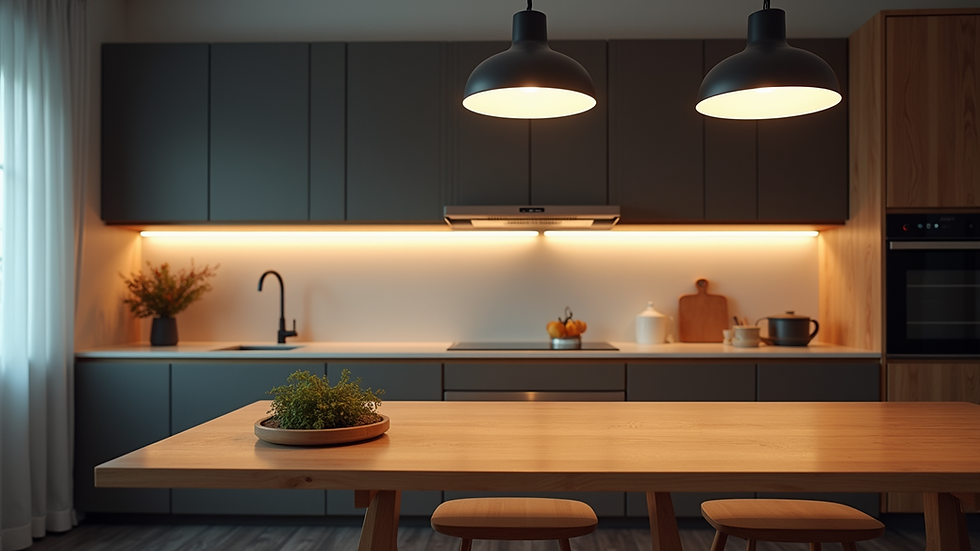Mastering the Art of Lighting Design
- MOSS Objects
- Oct 6
- 4 min read
Lighting is more than just a functional necessity; it is an art form that shapes the atmosphere, mood, and perception of any space. Whether you are designing a cozy living room, a vibrant restaurant, or a professional workspace, understanding the essentials of lighting can transform your environment dramatically. This guide will walk you through the key principles and practical tips to master the art of lighting design.
Understanding Lighting Design Essentials
Lighting design is a complex discipline that combines creativity with technical knowledge. At its core, it involves the strategic placement and selection of light sources to enhance the aesthetics and functionality of a space. Here are some fundamental concepts to keep in mind:
Types of Lighting: There are three main types of lighting to consider:
1. Ambient Lighting: The general illumination that provides overall visibility.
2. Task Lighting: Focused light that helps perform specific activities like reading or cooking.
3. Accent Lighting: Used to highlight architectural features, artwork, or decorative elements.
Color Temperature: Measured in Kelvins (K), color temperature affects the mood of a room. Warm light (2700K-3000K) creates a cozy atmosphere, while cool light (4000K-5000K) is energizing and ideal for workspaces.
Light Intensity and Distribution: The brightness and spread of light should be balanced to avoid glare and shadows.
Layering Light: Combining different types of lighting creates depth and interest.
For example, in a living room, you might use a combination of recessed ceiling lights for ambient lighting, a floor lamp for task lighting near a reading chair, and wall sconces to accentuate artwork.

What does a Lighting Designer do?
A lighting designer is a professional who plans and implements lighting schemes for various environments. Their role goes beyond simply choosing fixtures; they consider how light interacts with space, materials, and human activity. Here’s what a lighting designer typically does:
Assessment and Planning: They analyze the space, its purpose, and the client’s needs.
Concept Development: Creating a lighting concept that aligns with the design vision.
Fixture Selection: Choosing appropriate light sources, fixtures, and controls.
Technical Specifications: Calculating light levels, energy consumption, and compliance with regulations.
Installation Oversight: Ensuring the lighting is installed correctly and functions as intended.
Adjustment and Fine-tuning: Making necessary tweaks to optimize the lighting effect.
For instance, in a theater, a lighting designer will create dynamic lighting scenes that enhance the storytelling, using a mix of spotlights, floodlights, and colored gels.

Practical Tips for Effective Lighting Design
Mastering lighting design requires both knowledge and practice. Here are actionable recommendations to help you create stunning lighting schemes:
Start with a Lighting Plan
Sketch your space and mark where different light sources will go. Consider the function of each area.
Use Dimmers and Controls
Installing dimmers allows you to adjust light intensity according to mood and time of day.
Choose Energy-Efficient Fixtures
LED lights are long-lasting and consume less power, making them a smart choice.
Consider Natural Light
Maximize daylight by using sheer curtains or reflective surfaces to reduce the need for artificial lighting.
Highlight Key Features
Use accent lighting to draw attention to artwork, plants, or architectural details.
Avoid Overlighting
Too much light can be harsh and uncomfortable. Aim for balanced illumination.
Experiment with Color
Colored lighting can create unique atmospheres but use it sparingly to avoid overwhelming the space.
For example, in a kitchen, under-cabinet LED strips provide excellent task lighting for food preparation, while pendant lights over the island add style and ambient light.

Incorporating Modern Trends in Lighting Design
Lighting trends evolve with technology and design preferences. Staying updated can help you create contemporary and functional spaces:
Smart Lighting Systems: Integrate smart bulbs and controls that allow remote operation and automation.
Minimalist Fixtures: Sleek, simple designs that blend seamlessly with interiors.
Sustainable Lighting: Focus on eco-friendly materials and energy-saving technologies.
Layered and Dynamic Lighting: Use multiple layers and adjustable color temperatures to adapt to different activities.
Statement Lighting: Bold, artistic fixtures that serve as focal points.
For example, the Emily Group of Five collection offers elegant pendant lights that combine minimalist design with warm illumination, perfect for modern interiors.
Enhancing Spaces with Thoughtful Lighting Choices
Lighting can dramatically influence how a space feels and functions. Here are some specific examples of how to enhance different environments:
Living Rooms: Use a mix of ambient and accent lighting to create a welcoming atmosphere. Floor lamps and table lamps add warmth.
Bedrooms: Soft, warm lighting promotes relaxation. Bedside lamps with adjustable brightness are ideal.
Offices: Bright, cool lighting improves focus and productivity. Task lighting at desks is essential.
Restaurants: Dim, warm lighting creates intimacy. Highlighting tables and decor enhances the dining experience.
Outdoor Areas: Use path lights, spotlights, and string lights to create safe and inviting outdoor spaces.
By carefully selecting and positioning lights, you can transform any room into a functional and beautiful environment.
Mastering the art of lighting design essentials is about understanding the interplay of light, space, and human experience. With thoughtful planning, creativity, and attention to detail, you can create lighting schemes that not only illuminate but also inspire. Whether you are a homeowner, designer, or enthusiast, these principles will guide you toward achieving perfect lighting in any setting.



Comments